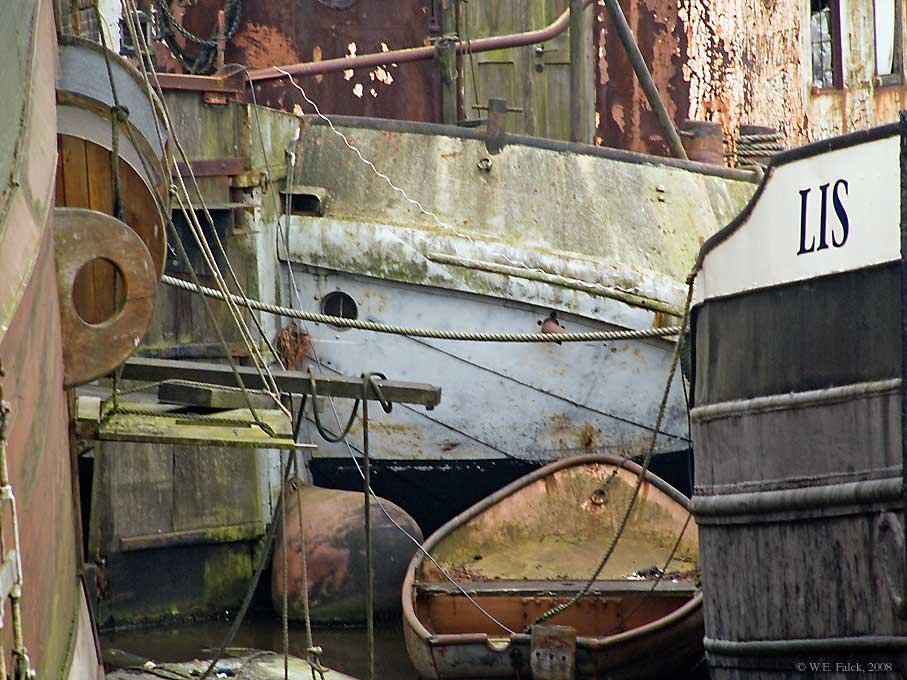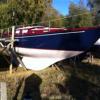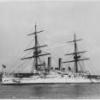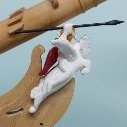MORE HANDBOOKS ARE ON THEIR WAY! We will let you know when they get here.
×
-
Posts
6,475 -
Joined
-
Last visited
Reputation Activity
-
 wefalck got a reaction from Obormotov in MONTAÑES by Amalio
wefalck got a reaction from Obormotov in MONTAÑES by Amalio
Somehow it is a pity that all the brilliant wood-work gets buried in more and more brilliant wood-work ...
-
 wefalck got a reaction from Retired guy in Germania Nova 1911 by KeithAug - FINISHED - Scale 1:36 - replica of schooner Germania 1908
wefalck got a reaction from Retired guy in Germania Nova 1911 by KeithAug - FINISHED - Scale 1:36 - replica of schooner Germania 1908
Well, we all seem to suffer from more or less from the same problem: the narrative I hear from time to time goes "why don't you do something useful with your fancy tools, such as making jewellery?"
While I am quite capable of repairing things around the house (and do it, given enough urgency and inconvenience ), I prefer the creative aspect of 'making' things over 'fixing' things ...
-
 wefalck got a reaction from Elia in Germania Nova 1911 by KeithAug - FINISHED - Scale 1:36 - replica of schooner Germania 1908
wefalck got a reaction from Elia in Germania Nova 1911 by KeithAug - FINISHED - Scale 1:36 - replica of schooner Germania 1908
Well, we all seem to suffer from more or less from the same problem: the narrative I hear from time to time goes "why don't you do something useful with your fancy tools, such as making jewellery?"
While I am quite capable of repairing things around the house (and do it, given enough urgency and inconvenience ), I prefer the creative aspect of 'making' things over 'fixing' things ...
-
 wefalck got a reaction from druxey in Germania Nova 1911 by KeithAug - FINISHED - Scale 1:36 - replica of schooner Germania 1908
wefalck got a reaction from druxey in Germania Nova 1911 by KeithAug - FINISHED - Scale 1:36 - replica of schooner Germania 1908
Well, we all seem to suffer from more or less from the same problem: the narrative I hear from time to time goes "why don't you do something useful with your fancy tools, such as making jewellery?"
While I am quite capable of repairing things around the house (and do it, given enough urgency and inconvenience ), I prefer the creative aspect of 'making' things over 'fixing' things ...
-
 wefalck got a reaction from Canute in Cutting ABS-hull?
wefalck got a reaction from Canute in Cutting ABS-hull?
A hand-held electrical drill with an abrasive cutting wheel might be another option.
-
 wefalck got a reaction from Canute in Cutting ABS-hull?
wefalck got a reaction from Canute in Cutting ABS-hull?
Whether plastics melt during mechanically working them depends on how much energy you put into them over what interface - or in simple terms: when you run the cutting tool too fast, you are putting too much energy into the cut ...
-
 wefalck got a reaction from FlyingFish in Germania Nova 1911 by KeithAug - FINISHED - Scale 1:36 - replica of schooner Germania 1908
wefalck got a reaction from FlyingFish in Germania Nova 1911 by KeithAug - FINISHED - Scale 1:36 - replica of schooner Germania 1908
Well, we all seem to suffer from more or less from the same problem: the narrative I hear from time to time goes "why don't you do something useful with your fancy tools, such as making jewellery?"
While I am quite capable of repairing things around the house (and do it, given enough urgency and inconvenience ), I prefer the creative aspect of 'making' things over 'fixing' things ...
-
 wefalck got a reaction from mtaylor in Germania Nova 1911 by KeithAug - FINISHED - Scale 1:36 - replica of schooner Germania 1908
wefalck got a reaction from mtaylor in Germania Nova 1911 by KeithAug - FINISHED - Scale 1:36 - replica of schooner Germania 1908
Well, we all seem to suffer from more or less from the same problem: the narrative I hear from time to time goes "why don't you do something useful with your fancy tools, such as making jewellery?"
While I am quite capable of repairing things around the house (and do it, given enough urgency and inconvenience ), I prefer the creative aspect of 'making' things over 'fixing' things ...
-
 wefalck got a reaction from FriedClams in Germania Nova 1911 by KeithAug - FINISHED - Scale 1:36 - replica of schooner Germania 1908
wefalck got a reaction from FriedClams in Germania Nova 1911 by KeithAug - FINISHED - Scale 1:36 - replica of schooner Germania 1908
Well, we all seem to suffer from more or less from the same problem: the narrative I hear from time to time goes "why don't you do something useful with your fancy tools, such as making jewellery?"
While I am quite capable of repairing things around the house (and do it, given enough urgency and inconvenience ), I prefer the creative aspect of 'making' things over 'fixing' things ...
-
 wefalck got a reaction from Roger Pellett in Germania Nova 1911 by KeithAug - FINISHED - Scale 1:36 - replica of schooner Germania 1908
wefalck got a reaction from Roger Pellett in Germania Nova 1911 by KeithAug - FINISHED - Scale 1:36 - replica of schooner Germania 1908
Well, we all seem to suffer from more or less from the same problem: the narrative I hear from time to time goes "why don't you do something useful with your fancy tools, such as making jewellery?"
While I am quite capable of repairing things around the house (and do it, given enough urgency and inconvenience ), I prefer the creative aspect of 'making' things over 'fixing' things ...
-
 wefalck reacted to Ab Hoving in Cut and Paste - downloadable e-book featuring the work of Ab Hoving
wefalck reacted to Ab Hoving in Cut and Paste - downloadable e-book featuring the work of Ab Hoving
I posted another picture PM Brian. I think it was the kaag you wanted?
Ab
-
 wefalck reacted to Ab Hoving in Cut and Paste - downloadable e-book featuring the work of Ab Hoving
wefalck reacted to Ab Hoving in Cut and Paste - downloadable e-book featuring the work of Ab Hoving
This is not a book that is officially on the market. My son and I made it just for fun.
We hope you like it too.
Cut_and_paste_ENG.pdf
-
 wefalck reacted to JCARLOSM in Fabrica de baseles
wefalck reacted to JCARLOSM in Fabrica de baseles
Hello, I bring you a very interesting book that the original is in the National Library of Spain. It is not pirated, it is posted on the network with the authorization of the authors.
Bye
Fabrica_de_baseles.pdf
-
 wefalck got a reaction from mtaylor in Cutting ABS-hull?
wefalck got a reaction from mtaylor in Cutting ABS-hull?
Whether plastics melt during mechanically working them depends on how much energy you put into them over what interface - or in simple terms: when you run the cutting tool too fast, you are putting too much energy into the cut ...
-
 wefalck got a reaction from mtaylor in Cutting ABS-hull?
wefalck got a reaction from mtaylor in Cutting ABS-hull?
A hand-held electrical drill with an abrasive cutting wheel might be another option.
-
 wefalck got a reaction from Canute in WARNER (2022): Warships of the First Schleswig War (1848-1850)
wefalck got a reaction from Canute in WARNER (2022): Warships of the First Schleswig War (1848-1850)
WARNER, W.E. (2022): Warships of the First Schleswig War (1848-1850): The Rise of Steam Naval Combat.- 209 p. (independently published through Amazon), ca. 32€.
Since 1460 the Danish Kings ruled in personal union as dukes in Schleswig (as a fief of the Danish Crown) and Holstein (as a fief of the German Confederation). This constitutionally complicated situation was exacerbated by the fact that German and Danish populations were mixed in the north of Schleswig. The efforts of the government in Copenhagen to tie both duchies more directly to the crown in the mid-19th century led to counter-movements by the German population, which culminated in the first of three wars in 1848, the 1st Schleswig-Holstein War (known in Denmark as the ‘Three Years' War`).
Since there are only a few works on the subject and these are usually kept rather short, such a 200-page book seemed a desirable addition.
But even at first glance one can see that it was cobbled together rather hastily. There is at least one, if not several, typos on every page that should have been easy to spot when proof-reading, if not already with the spelling-checker in the word processor. A striking example is the legend on p. 13, in which Flensburg appears in Danish spelling once as Frensborg, twice as Flenborg and once each as Flesborg and Felsborg, sometimes in the same sentence ... In addition, there are incomplete and incoherent sentences on practically every page. Some paragraphs and whole chapters look like automatic translations from Danish or German. For significant stretches the text actually reads like German or Danish with English words.
Speaking of 'Flensborg': it is not entirely understandable why the Danish spelling of the place names was predominantly used, even for Holstein areas, where this may have only appeared in official documents in Copenhagen. A Danish-German-English comparison table on page 202 indicates that for place names in the text predominantly the German version was used, which is de facto incorrect.
It is also frustrating that the text and action maps do not always match, i.e. the text mentions places that are not marked on the maps, so you have to constantly consult an atlas to understand the text.
Such a lack of formal care usually undermines any confidence in the reliability of content. The historical overview then indeed suggests that the author only deals very cursorily with the complex history of Schleswig-Holstein and has not developed a deeper understanding of the mixture of conflicting interests. However, I did not check the factual accuracy of the historical outline against the literature available to me. As a curiosity, Appendix 4 could be mentioned, in which the Danish Espignol is described, but a quick Internet search reveals that the author did not bother to really understand the function and arrangement of this volley gun.
The title of the book suggests that it is about the warships used in this conflict and we are lucky that the Danish archives are quite rich on virtually every ship named in it, including various of those used by the German forces, as they were either of Danish origin or ended up in Danish hands. I would have expected to see this source material mentioned and perhaps referenced for easy look-up. Instead, the ships are only illustrated by way of drawings that presumably are based on an interpretation of this archival material and reproductions of some historical works of art that were often made decades after the event. Similarly, the armament of the ships used is discussed only briefly, with the exception of the espignols mentioned above, which also appear to have been used abord of Danish ships.
Interesting is an appendix that discusses the housing in Copenhagen of PoWs and civilian detainees, including the seamen from German merchant ships taken as prizes or seized in harbours. Hulks of old navy ships were used for the purpose, as in the days of e.g. the Napoleonic Wars.
The list of references in such works is always interesting to peruse, as it shows how thoroughly the author has consulted the contemporary and secondary literature. It is quite striking that little German literature was used. For example, there is a sub-heading for ‘official Danish sources’, but noting corresponding for German sources (which admittedly are more scanty due to war losses).
One can easily see from that that the book was obviously hastily pieced together from various contributions in a Facebook forum (mentioned in the foreword) without having undergone a thorough editorial processing (NB, the author put proudly his PhD onto the front cover, but if it were his thesis, the supervisor would have turned it back to him after reading a couple of pages …).
The final question: “Is it worth buying the book?” can be answered with a pretty clear ‘no’. The book has a lot of potential, but would need to be revised very thoroughly in terms of content and form.
-
 wefalck reacted to Amalio in MONTAÑES by Amalio
wefalck reacted to Amalio in MONTAÑES by Amalio
For me, ship modeling is a real pleasure, not only when you finish something, but also throughout the construction process. I love the time I spend in my workshop and I don't pay attention to the time it will take to finish a model, nor to the amount of work involved.
It happens to me that when I finish a model I feel a certain sensation of sadness because I will no longer be able to continue enjoying it.
-
 wefalck got a reaction from mtaylor in MONTAÑES by Amalio
wefalck got a reaction from mtaylor in MONTAÑES by Amalio
Somehow it is a pity that all the brilliant wood-work gets buried in more and more brilliant wood-work ...
-
 wefalck got a reaction from VonHoldinghausen in Cutting ABS-hull?
wefalck got a reaction from VonHoldinghausen in Cutting ABS-hull?
Whether plastics melt during mechanically working them depends on how much energy you put into them over what interface - or in simple terms: when you run the cutting tool too fast, you are putting too much energy into the cut ...
-
 wefalck got a reaction from coxswain in MONTAÑES by Amalio
wefalck got a reaction from coxswain in MONTAÑES by Amalio
Somehow it is a pity that all the brilliant wood-work gets buried in more and more brilliant wood-work ...
-
 wefalck got a reaction from mtaylor in Small Boats: 18 foot Cutter, Jolly Boat, Captain's Gig
wefalck got a reaction from mtaylor in Small Boats: 18 foot Cutter, Jolly Boat, Captain's Gig
It all boils down to period and nation ... from around the middle of the 19th century on it seems that navies pretty much standardised their boats and the terminology. In each class of boats there may have been two or three different sizes, i.e. lengths. The standardisation made it easier to contract out their building and getting exactly what was required to fit onto the ships e.g. with respect to the distance of davits.
Between the last quarter of the 19th century and the end of WWI both, the German and the Austrian navies used all three types of construction: clinker, carvel and diagonal-carvel. All three building methods have their respective merits. Larger boats typically were either carvel or diagonal-carvel. Clinker building makes for a heavier, but more sturdy boat.
I gather one can discuss for weeks the etymology and use of the different terminologies ...
-
 wefalck got a reaction from mtaylor in Tuning Copper sheathing
wefalck got a reaction from mtaylor in Tuning Copper sheathing
Before reading all the others' comments, I thought immediately the idea was to ensure that both, keel and false-keel were properly wrapped in copper. The false-keel was a sort of expendable item, meant to protect the actual keel from damage. In case it was (partially) ripped off by grounding etc., the keel still needed to be properly protected from this nasty digging animal.
-
 wefalck got a reaction from AON in Small Boats: 18 foot Cutter, Jolly Boat, Captain's Gig
wefalck got a reaction from AON in Small Boats: 18 foot Cutter, Jolly Boat, Captain's Gig
It all boils down to period and nation ... from around the middle of the 19th century on it seems that navies pretty much standardised their boats and the terminology. In each class of boats there may have been two or three different sizes, i.e. lengths. The standardisation made it easier to contract out their building and getting exactly what was required to fit onto the ships e.g. with respect to the distance of davits.
Between the last quarter of the 19th century and the end of WWI both, the German and the Austrian navies used all three types of construction: clinker, carvel and diagonal-carvel. All three building methods have their respective merits. Larger boats typically were either carvel or diagonal-carvel. Clinker building makes for a heavier, but more sturdy boat.
I gather one can discuss for weeks the etymology and use of the different terminologies ...
-
 wefalck reacted to gjdale in The Shipyard at Foss' Landing (Diorama) by gjdale (Grant) - FINISHED - SierraWest - Scale 1:87 (HO)
wefalck reacted to gjdale in The Shipyard at Foss' Landing (Diorama) by gjdale (Grant) - FINISHED - SierraWest - Scale 1:87 (HO)
Thanks one and all once again for all the kind comments and likes. Progress has been slow but steady, so it's time for an update.
The Yard Master’s Office
The Yard Master’s Office introduces a slightly new technique for this build. Here we see for the first time the use of clapboard siding. (I believe that in Australia we call this simply “weatherboard”). To achieve this while still using a board-on-board construction technique, the kit designer has cleverly made use of laser cutting to provide a substrate with the correct angles pre-cut. It is then a fairly simple process to apply the boards (prepared in the same manner as previous boards) to the substrate in perfect alignment.
Here is a super-close-up to show the design/construction process.
In reality, this is so subtle that it wasn’t until I turned the substate end on that I realised what had been provided. Very clever!
Here is another “in-progress” shot:
And all three walls with siding applied and trimmed up.
Some bracing is added to the interior side of the walls (to help prevent warping), and the inside front corners of the two side walls are then bevelled to allow a snug fit with the front wall.
Each wall then has windows/doors and window shades applied in the same manner as previously described. The front wall also receives a cast resin vent, that is “rusted up” before gluing in place.
Here is the completed Front Wall:
The Left Wall (complete with Yard Master sign on the door):
And the Right Wall:
The walls are then glued up. The rear wall is simply a piece of laser-cut card as it will be glued up against the front of the Warehouse. View blocks are also added.
A pre-cut roof substrate is then added, and the ends covered with a fascia board.
The roof is then shingled in the same manner as the main building. It was at this point that I realised that I was going to run out of shingle material. I reached out to the kit designer/provider via email and received a response within 6 hours, saying that he would be cutting more shingles next week and would put some extras in the post for me then. Now that’s what I call customer service!
Here is where I got to before running out of shingles:
I have some more things that can be progressed while waiting for the extra shingles to arrive…
-
 wefalck got a reaction from bruce d in Tuning Copper sheathing
wefalck got a reaction from bruce d in Tuning Copper sheathing
Before reading all the others' comments, I thought immediately the idea was to ensure that both, keel and false-keel were properly wrapped in copper. The false-keel was a sort of expendable item, meant to protect the actual keel from damage. In case it was (partially) ripped off by grounding etc., the keel still needed to be properly protected from this nasty digging animal.











